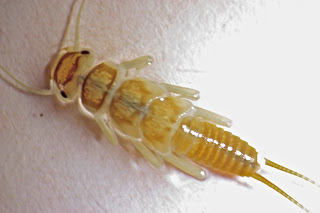There is no common name for Perlodid stoneflies -- though fly fisherman refer to the adults as "Yellow Sallies" (the adult is either pale green or pale yellow). This is a nymph that, in the field, can be confused with a "Common stonefly" (family Perlidae), even by experienced samplers. The two nymphs have a similar overall shape, and both can be quite colorful. But, the Common stonefly has bushy gills behind each of its legs; the Perlodid has none (it's "clean shaven" as it were). The Common stonefly's gills can usually be seen with a loupe (magnification).
The nymph in the photo above is genus Isoperla and, in my opinion, it's one of the prettiest nymphs we see in our streams. Nymphs this size normally show up in our samples in mid to late spring -- April and May. The stripes on the abdomen are a dead giveaway for Perlodid identification (but they might not be visible without magnification). It is my impression that Isoperla Perlodids are relative "late bloomers": Stewart and Stark (Nymphs of North American Stonefly Genera: Plecoptera, 2002) note emergence dates of June through mid-August in one study conducted in Alaska.
Perlodid nymphs -- I think I'm right in saying this -- do not show up in samples done in the fall (and rarely -- if at all -- in those done in the summer). I started to find very small Perlodid nymphs this year in samples done in early November. To date, I have only seen two genera (Peckarsky et.al., Freshwater Macroinvertebrates in Northeastern North America, list a total of 12 Perlodid genera). The genus I'm seeing the most is Clioperla (the photo above left shows a mature Clioperla nymph). Anatomically, Clioperla and Isoperla nymphs are very close, but if the nymph is large enough, the head pattern of the Cliopera nymph gives it away. As we can see in the head close-up above, there is a dark margin at the front, back, and sides of the head surrounding a region of yellow.
The other genus I'm seeing right now is Diploperla (this one was found two weeks ago; the wing pads are not fully developed). This genus cannot be identified in the field; that requires microscope work at the lab. For those of you who REALLY want to know what makes a Diploperla nymph Diploperla -- the lacinia is very distinct, and the Y-arms of the mesosternum are incomplete (!).
I am anxious to see if trips afield throughout the winter will reveal other Perlodid genera in our local streams, and to see when Isoperla nymphs begin to appear. My guess at the moment is that the pale green and yellow adults fishermen see hatching in April are Clioperla and/or Diploperla.




No comments:
Post a Comment